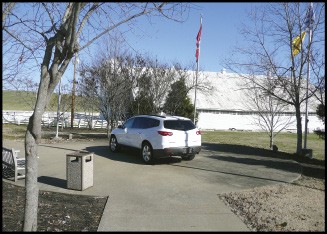The first road trip I remember taking was from Michigan to Florida in a dull blue 1955 Chevrolet with a V-8 engine, one of 1,690,000 sturdy Chevy’s made in that record year for General Motors.
The last Tennessee road trip I made was just before Christmas from Memphis to Chattanooga with my son Jack in his trusty 1998 Chevy Blazer with 198,000 miles on the odometer. Don’t tell me GM makes crappy cars that nobody wants. I bought the car used for $9,000 when Jack was in college at UT-Knoxville, and it has survived six years of fender benders, break-ins, and countless hunting and fishing trips from the Smokies to the Mississippi River bottomlands, usually towing a johnboat.
This trip would push the Blazer near the once mythical 200,000-mile mark. The weather was a Michigan-like 18 degrees, a suitable challenge for the occasion. The sun was shining, and we filled the tank for $20 with cheap gas, the mother’s milk of the SUV.
Jack was going to a wedding before leaving Tennessee for Montana. I was going along for the ride to eyeball the car manufacturing business that migrated to Middle Tennessee, as I did 30 years ago, along with millions of Midwesterners. Car towns like Spring Hill, Chattanooga, Smyrna, and Decherd are to Tennessee in the 21st century what Dearborn, Flint, Pontiac, and River Rouge were in the second half of the 20th century to Michigan.
A week earlier, U.S. senator Bob Corker of Chattanooga emerged as the Republican Party’s point man on the Detroit bailout. He sparred with the United Auto Workers (“We were this close”) and GM CEO Rick Waggoner (“You’re the problem”) in iconic television clips from the congressional hearings. A wealthy developer, Corker worked at Western Auto as a kid, graduated from UT-Knoxville, and was once a card-carrying union member. He owns a 1997 Toyota with 180,000 miles and a vintage Ford pickup truck. I have nothing against Corker or foreign cars. I drive a used Mercedes made in Alabama. But I have a soft spot for the UAW. You’d have to be an idiot or an ingrate not to acknowledge your debt to the UAW if you’re a baby boomer from Michigan.
What was good for General Motors may or may not have been good for America, but it was certainly good for Michigan, no matter where you worked. My friends and I went to state universities for a generously subsidized $480 a year in tuition, easily covered with earnings from factory jobs in the summer, meal jobs during school, and money left over for enough Carling Black Label and Stroh’s to ensure that we would not be invited to join Phi Beta Kappa. I can still remember where I was in 1970 when I heard that Walter Reuther had died in a plane crash. I doubt if one in 10 Americans these days can identify the labor leader who bargained with the Big Three for health and pension obligations in contract talks in 1950 and 1951 when they were on top of the world, setting the stage for the current crisis.

Bob Corker
Detroit was king in the ’50s. My favorite novel about the era is Edsel, by the Detroit writer Loren Estleman. Reuther and Henry Ford II are cast in a fictional reconstruction of the rollout of Ford’s disastrous Edsel, and the narrator is an aging ex-newspaper columnist whose time has passed him by.
The two Detroit newspapers were full of gloomy reports the week of my recent road trip, with several of them targeting Corker for his insistence that the UAW agree to givebacks by a specific time in order to get a bailout. A sampler: “More Are Saying So Long to Michigan”; “Union Members Have Messed Things Up”; “Shame on Sen. Corker”; and “Michigan’s Growth Stagnant While Other Parts of the Country See Robust Growth.”
Corker, formerly the state finance commissioner and the mayor of Chattanooga, told me this week that he feels misportrayed in the national media by Washington Post columnist David Broder and others. “I could not believe he lumped me in with folks who were not trying to make a deal happen,” Corker said. “We wanted to solve the problem in such a manner that the car companies would not have to come back and ask for more money.”
Corker said he was stunned that the UAW did not agree to being competitive with Honda, Toyota, Nissan, and BMW on reduced wages and benefits for active employees. The hangup was the month, day, and year they would go into effect.

1
“I went to Washington to try to solve problems,” Corker said, “and I felt like I got within three words of solving this one.”
The growth of Tennessee at Michigan’s expense has been especially robust. The headquarters of Nissan North America is in Smyrna, just south of Nashville. Nissan also has a powertrain assembly plant in Decherd in Middle Tennessee. Volkswagen is building its first U.S. factory in two decades in Chattanooga and expects to turn out 250,000 cars a year in 2012. The granddaddy of them all is GM’s plant in Spring Hill, “the 14th fastest growing city in the United States” according to welcome signs. Adding insult to injury, in Nashville the Tennessee Titans were clinching homefield advantage for the NFL playoffs on this Sunday, while in Detroit the Lions were going 0-15.
Memphis, which was home to a Ford assembly plant until 1959, somehow missed the action. There are a dozen foreign and domestic car factories within 500 miles of Memphis and its 670,000 residents but none within 200 miles, except the future Toyota plant in Tupelo which has been delayed.
Corker said he’s not sure why that is.
“There are some sites in rural West Tennessee trying to get megasite status, and I am committed to working with them,” he said. “We’ve created a niche for ourselves. Companies have seen that they can make money in Tennessee.”
But Middle Tennessee’s party may be toned down for a while. The Spring Hill plant retooled in 2008, aborted the Saturn Vue, and started making a crossover SUV/minivan called the Chevy Traverse instead, just in time for the recession and GM’s imminent bankruptcy. The tours had been canceled and the visitor center was almost empty when we arrived in Spring Hill three days before Christmas. The attendant said the plant was shutting down the next day. The last Traverse would roll off the line just 18 years after the celebrated Saturn debuted.

2
In the most optimistic scenario, the plant will reopen in February 2009. In the worst scenario, it will remain closed indefinitely, two decades of prosperity will slowly unwind, and Middle Tennessee will get a taste of what Detroit is going through.
R.I.P., Walter.
Shot 1: Spring Hill
Behind this bucolic white, wooden fence and field sits a General Motors assembly plant, one of the first big Southern victories in the dismantling of Detroit. GM made the announcement in 1985 that it would build the Saturn on a horse farm in Spring Hill, 30 miles south of Nashville. By agreement, the site was dug into the ground behind a berm so that it is nearly invisible from U.S. Highway 31. More than 5,000 people worked at the plant at its peak. The first Saturn rolled off the line in 1990, a model that looks strikingly similar to my daughter’s well-traveled 1995 Saturn. In 2007, the plant stopped making the Saturn Vue, which is now made in Mexico. There is speculation in the Detroit newspapers that GM will soon sell Saturn.
“I think Spring Hill is one of those assets that, even if GM were to go bankrupt, it would survive and thrive,” Corker said.

3
Shot 2: Saturn Visitor Center
The visitor center used to be a stable. It displays the very first Saturn manufactured with the joint blessing of the United Auto Workers union and GM management, led at the time by CEO Roger Smith, the subject of filmmaker Michael Moore’s breakthrough movie Roger and Me. Inspirational quotations from Smith are featured on banners hanging from the ceiling. Moore is from Flint, Michigan. Spring Hill is everything Flint is not — a scrubbed, manicured, prosperous place that boomed from 1985 until today. My favorite exhibit in the visitor center is a shopping cart loaded with two bags of groceries and mounted on a motorized track. Push a button and the cart rolls down the track and crashes into a Saturn polymer door panel without leaving a mark.
Shot 3: White Chevy Traverse
This 2009 Chevy Traverse sits outside the visitor center in Spring Hill. It looks sort of lonely, as it should. The last one rolled off the line on December 23, 2008, its life span possibly just one year. Billed as “the crossover where beautiful and useful come together in perfect balance,” it was instead the crossover where overproduction met irrelevance in the perfectly disastrous year of 2008. The list price is $28,000, and it gets 24 miles per gallon on the highway, which GM says is the best in its class. After a brief spike to $4 per gallon, however, the price of gasoline dropped like an axle late last yeat, making fuel economy less urgent. On this day, we filled up for $1.36 a gallon. My son suggested we offer $18,000 to take the Traverse away. I didn’t have the heart.
Shot 4: Decherd water tower

4
Like something from The War of the Worlds, this water tower looms over the town of Decherd, home of a Nissan powertrain assembly plant. Decherd is in a beautiful valley about 100 miles southwest of Nashville, between the Jack Daniel’s and George Dickel distilleries. Wages are lower here than they are at the plants in the Midwest, and Decherd looks less prosperous but more authentic than Spring Hill or Smyrna. The little houses are neatly kept but older, and there is a roller-skating rink, drive-in movie theater, locally owned cafes, horse farms, and several impressive-looking fireworks stands not far away. It reminded me, as it probably did Nissan’s site-selection team, of the way small-town America used to look.
Shot 5: Nissan factory in Smyrna
Even Nissan is feeling the pain of the recession. This plant in Smyrna was closed for three days before Christmas. The headquarters of Nissan North America is just outside of Nashville on Interstate 24, halfway to Murfreesboro, and contributes mightily to the Middle Tennessee boom. Residents clogged the interstate for miles on Sunday heading for the Titans-Steelers game. The 1998 Chevrolet Blazer in this picture has nearly 200,000 miles on it and was manufactured in Ohio. If it has a fault, from GM’s perspective at least, it is that it lasted too long, giving its owner little incentive to buy a newer one.

5





